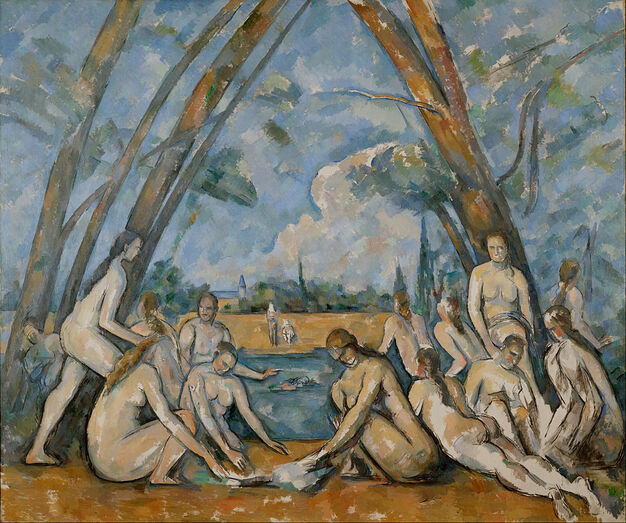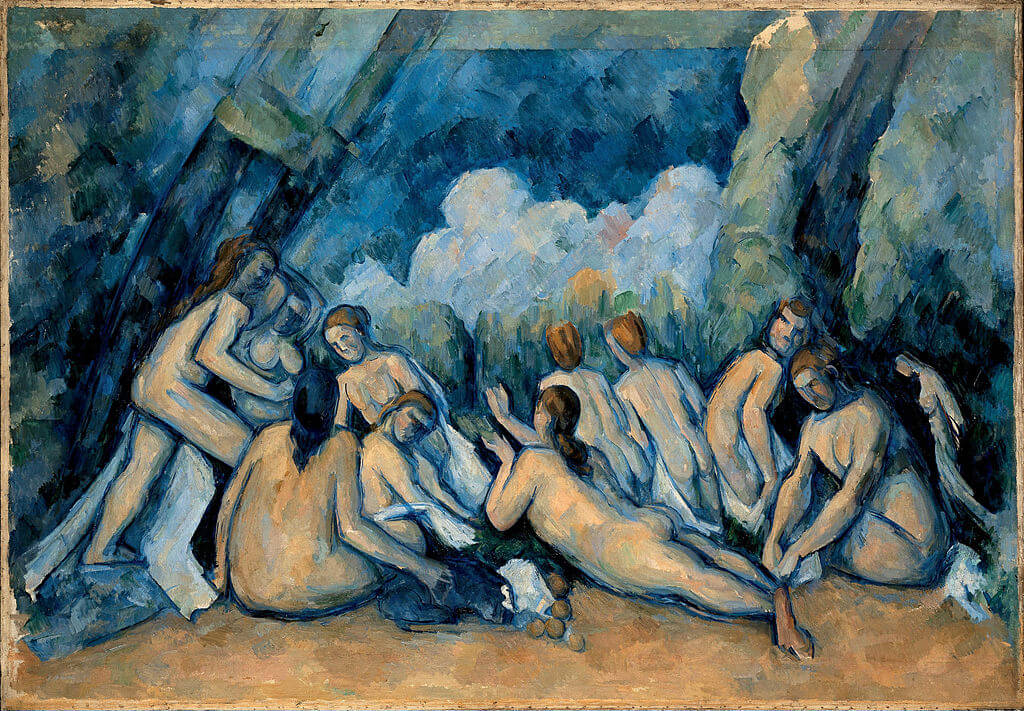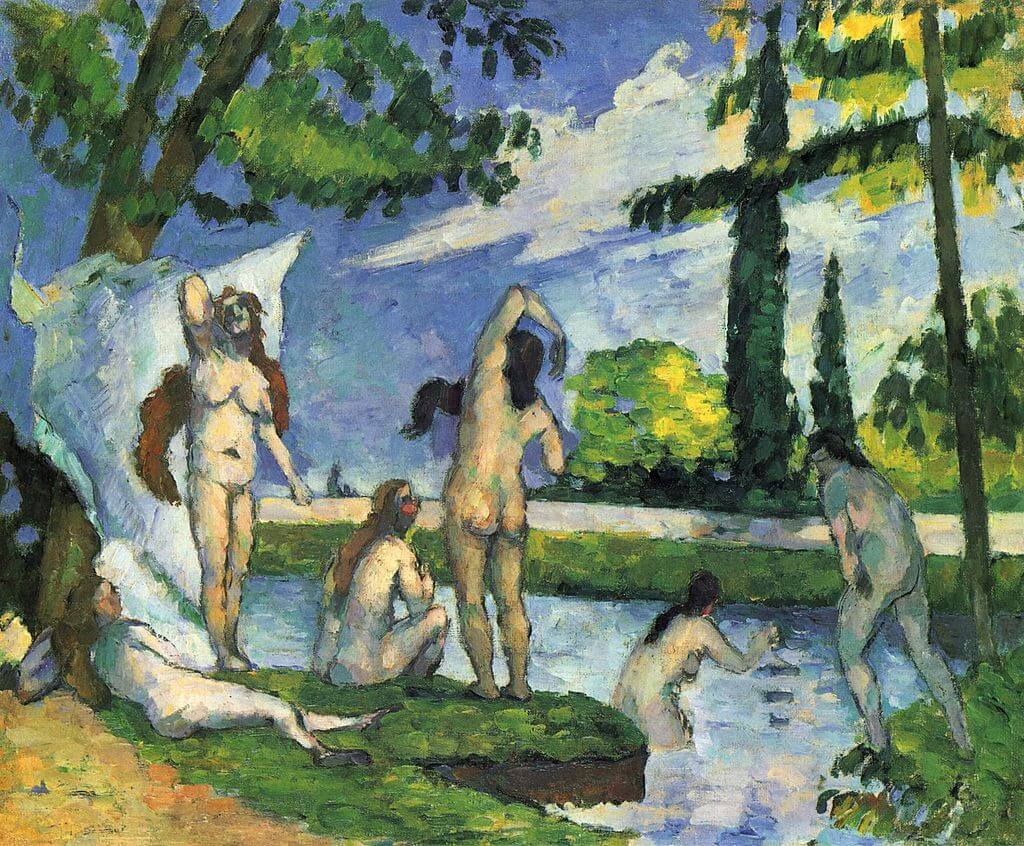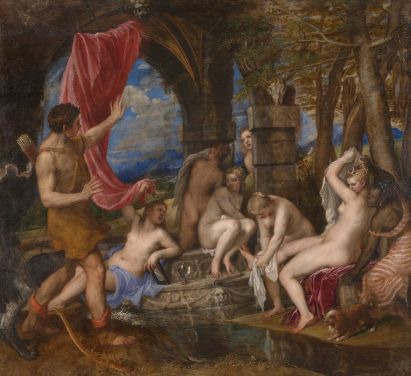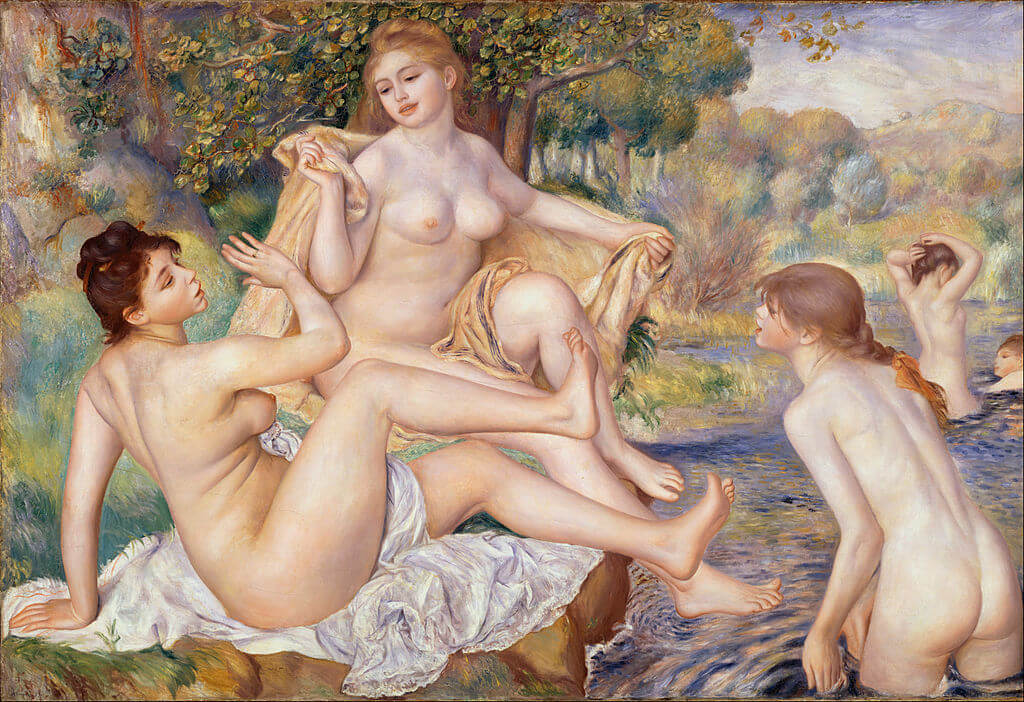|
Where? Gallery 164 of the Philadelphia Museum of Art
When? 1898-1905 What do you see? A group of women bathing near a river. There are two groups of women in the foreground; a group of six women on the left and a group of eight women on the right. In the middle of these two groups, you can see a river with someone swimming in it and on the other side of the river you can see the back of a man walking with a horse beside him. In the background, we can see a landscape with large cypresses, a church tower, and a blue sky with clouds. The middle of the painting has its own frame, bounded by the trees that are growing towards each other. Looking in more detail, the bodies of the women in this painting are not very realistic. They are malformed (look for example at the incorrect proportions of the tall woman standing on the left). In addition, none of the women in this painting has an identifiable face. Also, quite some parts of the human bodies are unfinished, and we can see the canvas underneath. For example, look at the horse or the woman lying on the right with her feet almost sticking out of the bottom of the canvas. Cézanne is showing the women more abstractly, and this painting had a big influence on the abstract paintings later in the 20th century. Backstory: Paul Cézanne worked for many years on this painting, and it was still unfinished when he died in 1906. He did not use any models for this painting but rather painted them from his imagination. During his life, he created about 200 paintings and drawings of nude bathers, but this painting is generally considered to be his best. Another version of the Bathers, painted around the same period as the painting in the Philadelphia Museum of Art, is in the National Gallery in London. The Metropolitan Museum of Art owns a much earlier version of Bathers, which was created between 1874 and 1875 and shows them in a more typical impressionist style.
Bathers in art: This painting of Cézanne combines a landscape of Aix-en-Provence in the South of France with a classical bathing scene. It shows some similarities to the painting of Diana and Actaeon by Titian which also contains a bathing scene. Titian depicted the group of bathers in a triangular composition, which is also true for the two groups of bathers in Cézanne’s painting (as well as the large triangle formed by the trees). Finally, both paintings have some opening in the middle in which we can see a distant landscape. Bathers have been a subject that has inspired more painters over time. For example, the Philadelphia Museum of Art also shows a painting entitled The Large Bathers by Renoir.
Who is Cézanne? Paul Cézanne (1839-1906) was born in Aix-en-Provence in 1839 and also died there in 1906. In his twenties and thirties, Cézanne spent considerable time living in Paris, where he developed a friendship with Camille Pissarro. The father of Paul Cézanne was a banker and financially supported him during his life, such that he could focus completely on his art. He was an Impressionist painter, but later in his life, he developed some more abstract paintings. Picasso and Matisse were heavily influenced by this later work of Cézanne and considered him to be ‘the father of us all’.
Fun fact: This painting of The Large Bathers is considered to be the best work by Cézanne. The painting has had a big impact on many future artists. Cézanne painted this at the end of his life and it was still unfinished when he died at age 76. It is not very common that painters create their masterpieces at the end of their career. According to academic research, painters peak at the age of 42. In other words, painters create their masterpieces, on average, at the age of 42, and after that, the quality of their work generally decreases. The reason is that the creativity of artists decreases at a higher age and when they get old they are also often limited by physical ailments. For example, Sandro Botticelli created his masterpieces The Birth of Venus and La Primavera when he was between 35 and 41 years old, and he only died at age 64.
Written by Eelco Kappe
0 Comments
Leave a Reply. |
Categories
All
|
- Home
- Blog
-
Museums
- Alte Pinakothek
- Art Institute of Chicago
- Baltimore Museum of Art
- Barber Institute of Fine Arts
- Bargello
- Barnes Foundation
- British Museum
- Church of Sant’Anastasia
- Cleveland Museum of Art
- Courtauld Institute of Art
- Detroit Institute of Arts
- Frans Hals Museum
- Galleria Borghese
- Gallerie dell'Accademia
- Getty Museum
- Guggenheim
- Hermitage Museum
- Kunsthistorisches Museum
- Kunstmuseum Basel
- Legion of Honor Museum
- Louvre
- Mauritshuis
- Metropolitan Museum of Art
- Musee d’Orsay
- Museum of Fine Arts in Boston
- Museum of Modern Art
- National Gallery in London
- National Gallery of Art
- National Museum in Poznań
- Norton Simon Museum
- Ny Carlsberg Glyptotek
- Palace of Versailles
- Palazzo Pitti
- Palazzo Vecchio
- Petit Palais
- Philadelphia Museum of Art
- Prado
- Pushkin Museum
- Ravenna Art Museum
- Rijksmuseum
- San Diego Museum of Art
- Santa Maria delle Grazie
- St. Peter's Basilica
- Städel Museum
- Statens Museum for Kunst
- Tate Britain
- Tate Modern
- Timken Museum of Art
- Uffizi
- Vatican Museums
- Wallace Collection
-
Artists
- Altdorfer
- Anguissola
- Berlin Painter
- Bosch
- Botticelli
- Boucher
- Bronzino
- Bruegel the Elder
- Brunelleschi
- Cabanel
- Caillebotte
- Canova
- Caravaggio
- Carpeaux
- Cezanne
- Cimabue
- David
- Degas
- Delacroix
- De Maria
- Donatello
- El Greco
- Fontana
- Fra Angelico
- Fragonard
- Gauguin
- Gentileschi
- Gericault
- Gonzalez-Torres
- Goya
- Hals
- Hogarth
- Hokusai
- Ingres
- Leonardo da Vinci
- Lippi, Filippo
- Longhi, Barbara
- Lorrain
- Makovsky
- Manet
- Massys
- Matisse
- Merian
- Michelangelo
- Mochi
- Modigliani
- Monet
- Panini
- Parmigianino
- Perugino
- Picasso
- Pisanello
- Raphael
- Rembrandt
- Renoir
- Reynolds
- Rivera
- Rodin
- Rubens
- Scultori
- Seurat
- Steen
- Tintoretto
- Titian
- Toulouse-Lautrec
- Turner
- Uccello
- Van der Weyden
- Van Dyck
- Van Eyck
- Van Gogh
- Van Hemessen
- Vasari
- Velazquez
- Vermeer
- Veronese
- Vigée Le Brun
-
Locations
- Books
- About Us

